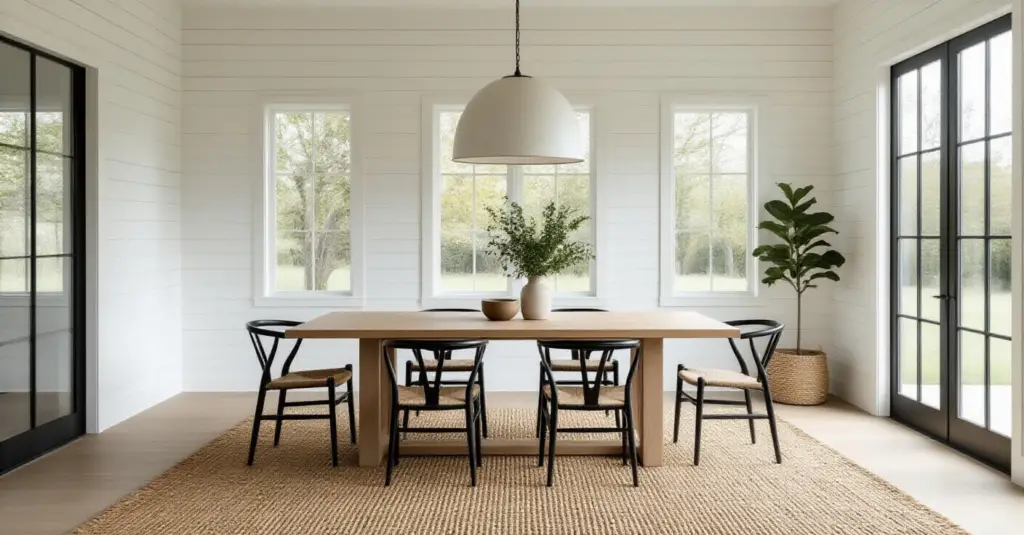Picture this: You’re standing in your dining room. But it doesn’t feel right. Maybe it’s too formal, or too generic, or just a place where you dump the mail. You want it to feel like those cozy, soulful farmhouse dining rooms you see online, the ones that look like a real family actually laughs and lives and eats there. But you’re busy, and the internet is full of corporate blogs telling you to buy a bunch of faux-distressed junk that all looks the same.
That’s the noise. What really matters isn’t buying a “farmhouse look.” It’s about creating a feeling. It’s understanding the psychology of why certain choices make us feel warm, welcome, and relaxed. Every choice you make, from the table to the light fixture, sends a subconscious message to you and your guests. I used to think it was just about picking pretty things, until I saw how a single wrong choice—like a too-small rug or harsh lighting—could kill the entire mood of a room and make people feel subtly anxious.
Forget the corporate checklists. I’m going to tell you what actually works. Here are the real-deal secrets to creating a farmhouse dining room that doesn’t just look good, but feels like home.
Establishing the Rustic Core: Planning Your Farmhouse Dining Room (Part 1)
This first part is the absolute most important, and it’s the one everyone wants to skip. Don’t. This isn’t about paint chips and Pinterest boards; it’s about setting the emotional intention for the space. If you get this wrong, you’ll just end up with a room full of expensive stuff you don’t love. Think of this as the foundation—not just of the room, but of the feeling you’re trying to build.
1. Define Your Specific Farmhouse Aesthetic (e.g., modern, classic, French)
Okay, let’s be honest. “Farmhouse” has become a meaningless marketing term. What really matters is asking yourself: how do I want to feel in this room? Do you want it to feel bright, clean, and efficient? That’s probably a modern farmhouse vibe. Do you want it to feel romantic, soft, and a little bit whimsical? You’re leaning toward French farmhouse. Do you want it to feel solid, historic, and grounded? You’re a classic, rustic farmhouse person.
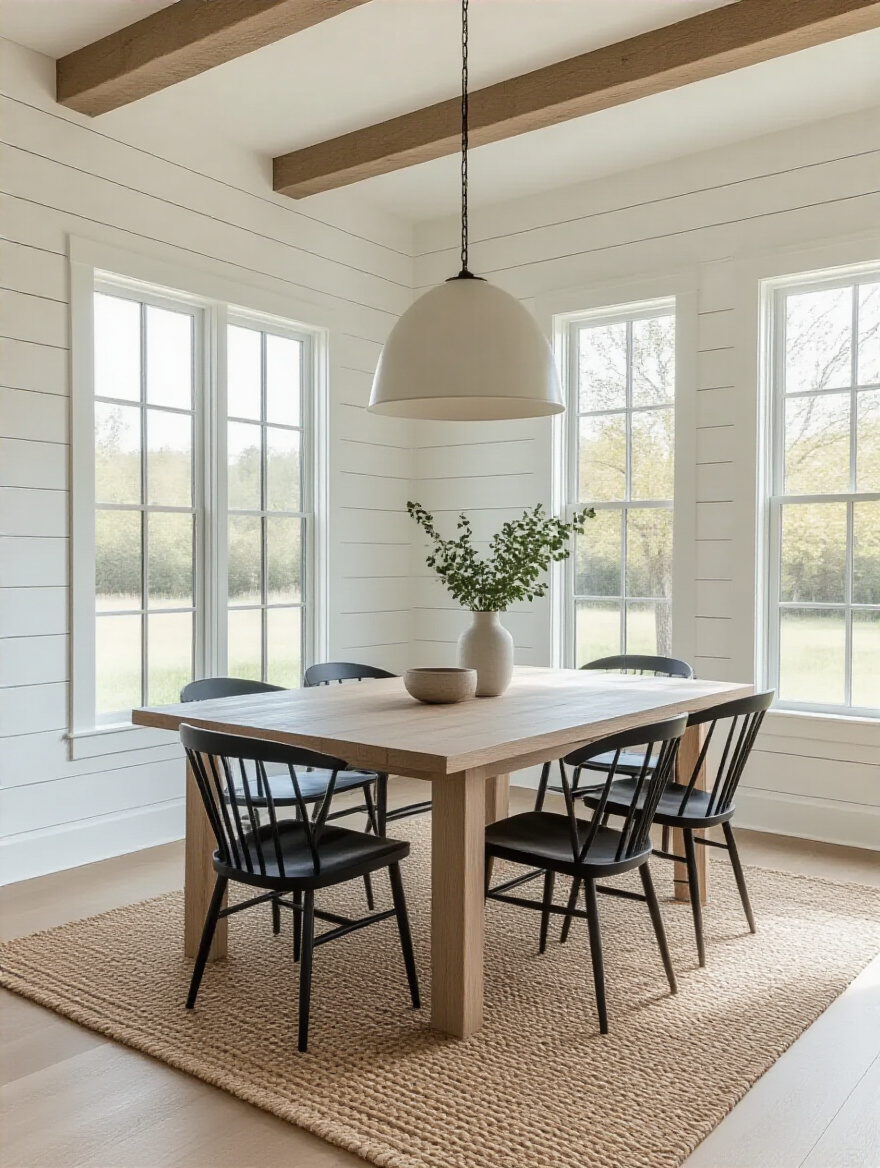
Don’t get caught up in the labels. Just look at images and pay attention to your gut reaction. The biggest mistake people make is mashing styles together without a clear emotional goal. A client of mine once had a sleek, modern farmhouse table, but paired it with ornate, French-style chairs and a clunky, rustic light fixture. The room felt disjointed and anxious because it was having three different conversations at once. Your job is to pick one conversation and stick with it.
This initial choice dictates everything else you’ll do, so spend real time on it. When you have that emotional direction, the thousands of choices you have to make suddenly shrink to a manageable handful. It’s your filter for everything that follows.
2. Optimize Your Dining Room Layout for Flow and Family Gatherings
Can we talk about why everyone gets this wrong? Flow isn’t just about being able to walk around the table without bumping your hip. From a psychological perspective, a room with bad flow creates subconscious stress. When pathways are blocked or chairs are too close to the wall, our brains register the space as cramped and unsafe, which makes us want to leave. A well-laid-out room, on the other hand, tells people they can relax, pull up a chair, and stay a while.
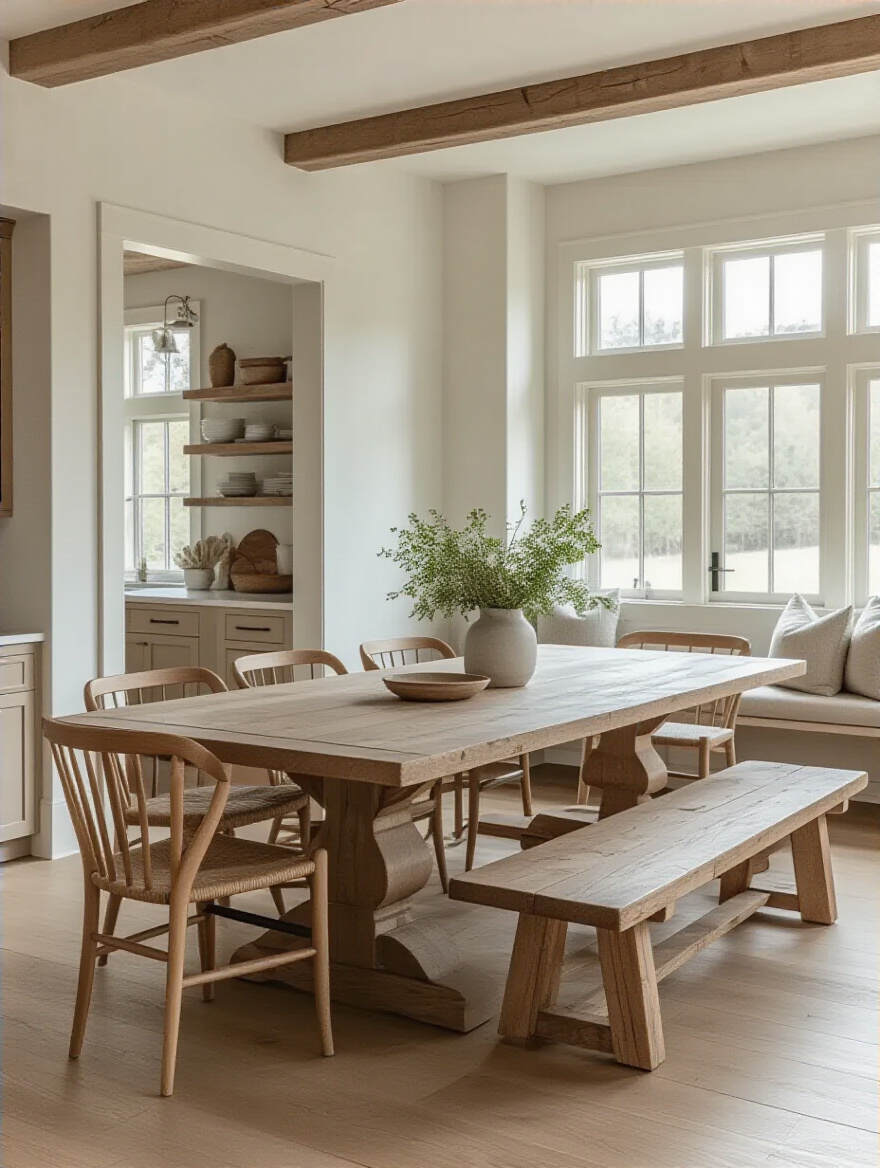
So, get out a tape measure. You need—and I mean need—at least 36 inches between the edge of your table and the wall or any other furniture. Anything less and people will feel trapped. I once had a client who insisted on a massive eight-person table in a tiny room. No one ever wanted to eat in there, and they couldn’t figure out why. We swapped it for a round pedestal table, and suddenly it became the most used room in their house. They had the same amount of seating, but the feeling was completely different.
The goal here isn’t to cram in more people; it’s to make the people you have feel comfortable and welcome. A well-planned layout is a silent invitation to connect.
3. Choose a Neutral Base Palette for Serenity and Versatility
I know what you’re thinking: “Neutrals are boring.” That’s corporate-speak BS meant to sell you more paint every year. In reality, a neutral palette—think warm whites, soft greys, creamy beiges—is the smartest psychological choice you can make for a dining room. Our brains are hardwired to find calm in these nature-inspired, non-threatening colors. It creates a serene backdrop that lowers our stress levels before we even sit down.
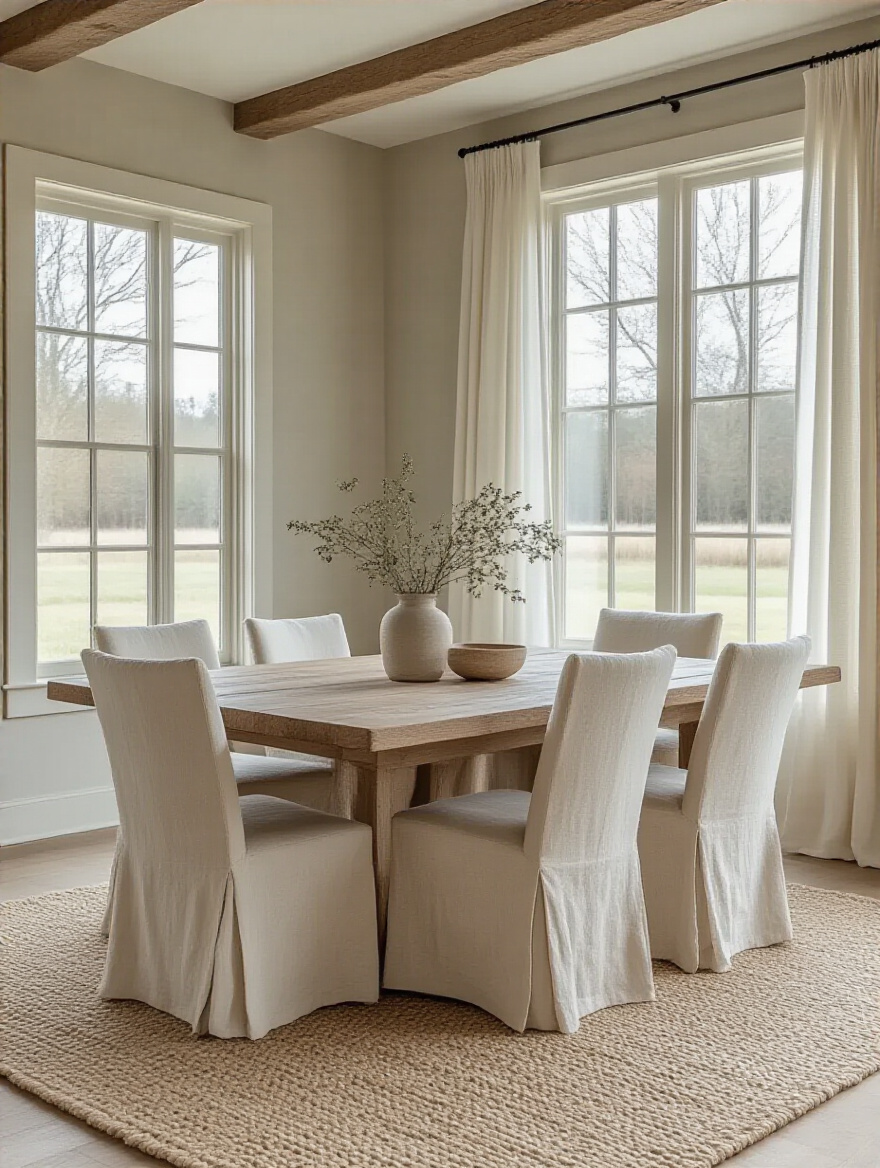
Think of it as the perfect canvas. A neutral room allows the people, the food, and the conversation to be the “color.” You can easily swap in seasonal flowers, colorful napkins, or different art without having to repaint the whole damn room. It’s not boring; it’s brilliant. The noise is that every room needs a “pop of color” on the walls. The truth is that most rooms need a deep breath and a sense of calm. A neutral base gives you that.
This isn’t about avoiding color. It’s about using color intentionally and letting your room breathe. Get the base right, and you can play with accents forever.
4. Prioritize Natural Light and Enhance Architectural Features
If I could give you only one piece of advice, this would be it. Natural light is the single most powerful tool for shaping the mood of a space. It’s a literal mood booster, flooding our brains with serotonin. So many people inherit beautiful windows and then suffocate them with heavy, dark curtains. It’s a design crime. You’re not just blocking light; you’re blocking a key source of happiness.
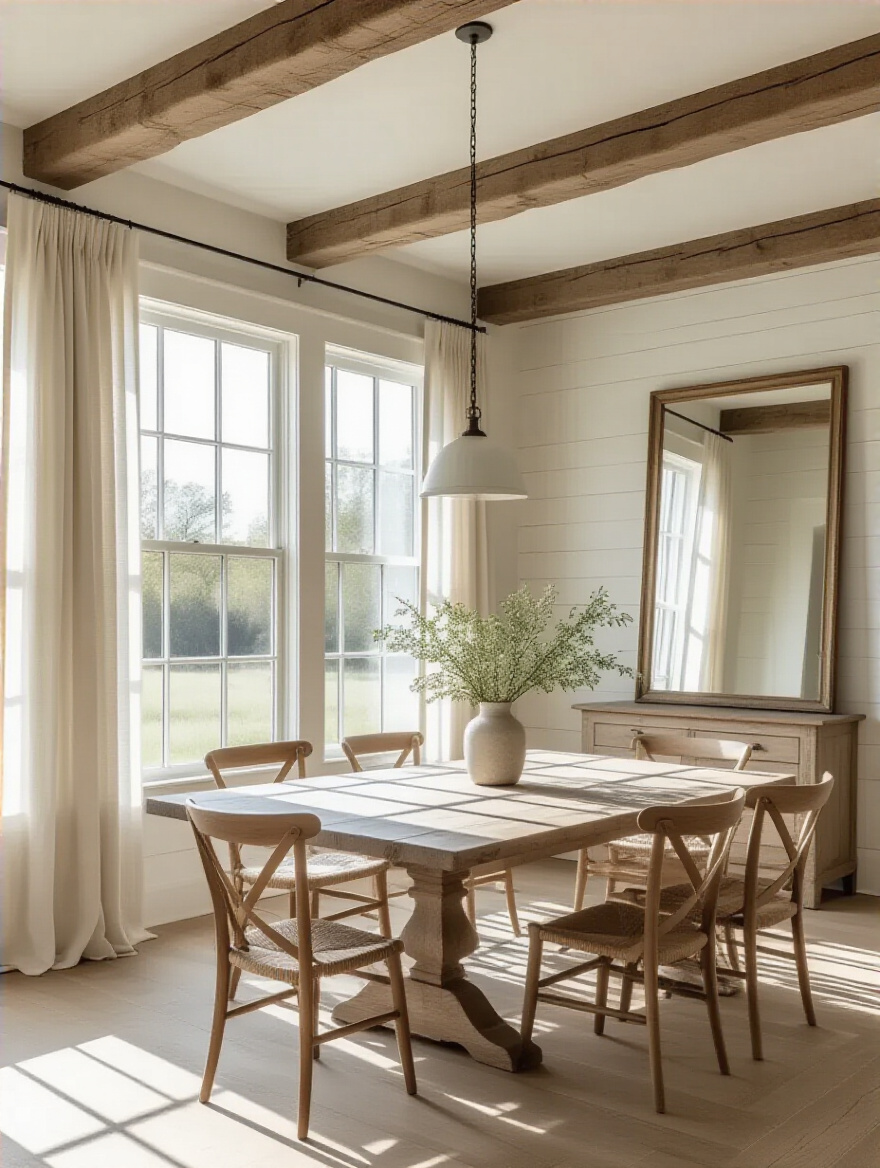
The goal is to let in as much light as humanly possible. If you need privacy, use sheer linen curtains that soften the light without blocking it. And if your room has any interesting features—exposed beams, shiplap, a cool old window frame—for the love of God, don’t hide them. Highlight them. These architectural details are the soul of a farmhouse. They tell a story of craftsmanship and history, which makes a space feel grounded and authentic.
Your next step is to start stripping things away. Before you add a single new piece of furniture, see how much you can enhance what’s already there by maximizing light and celebrating character.
Establishing the Rustic Core: Planning Your Farmhouse Dining Room (Part 2)
Okay, now that you’ve set the emotional stage, it’s time to bring in the main characters: your furniture. This is where you’ll spend your money, so it’s crucial to get it right. Remember, these aren’t just objects. They are the tools you’ll use to live out the vision you just created.
5. Identify Must-Have Farmhouse Furniture Pieces for Your Lifestyle
Forget what the catalogs tell you. Your lifestyle dictates your furniture, not the other way around. Do you have three kids who do homework at the dining table? Then you need a durable, scratch-resistant surface and chairs that can be easily wiped down. Are you a couple who hosts epic dinner parties? Then an extendable table and comfortable upholstered chairs are your priority. The worst thing you can do is buy furniture for a fantasy life you don’t actually live.

“The most effective farmhouse dining rooms skillfully blend a visually warm, inviting aesthetic with the practical resilience needed for daily life.”
I had a client who bought a gorgeous, delicate dining set, but her family was so scared of ruining it that they ate every meal in the kitchen. The beautiful dining room became a museum. We swapped it for a solid mango wood table and washable slipcovered chairs, and it instantly became the heart of their home. Function first. Always. The beauty will follow.
Don’t shop for furniture. Shop for solutions to your daily life. The right pieces will feel like they were made just for you.
6. Plan Your Decor Budget Wisely for Key Investments
Here’s a shortcut I wish I’d known years ago: your budget isn’t about what things cost, it’s about what they’re worth to your daily experience. Spend your money on the things you touch, see, and use every single day. That means the majority of your budget should go to two things: the table and the chairs. These are the workhorses. They’re foundational.
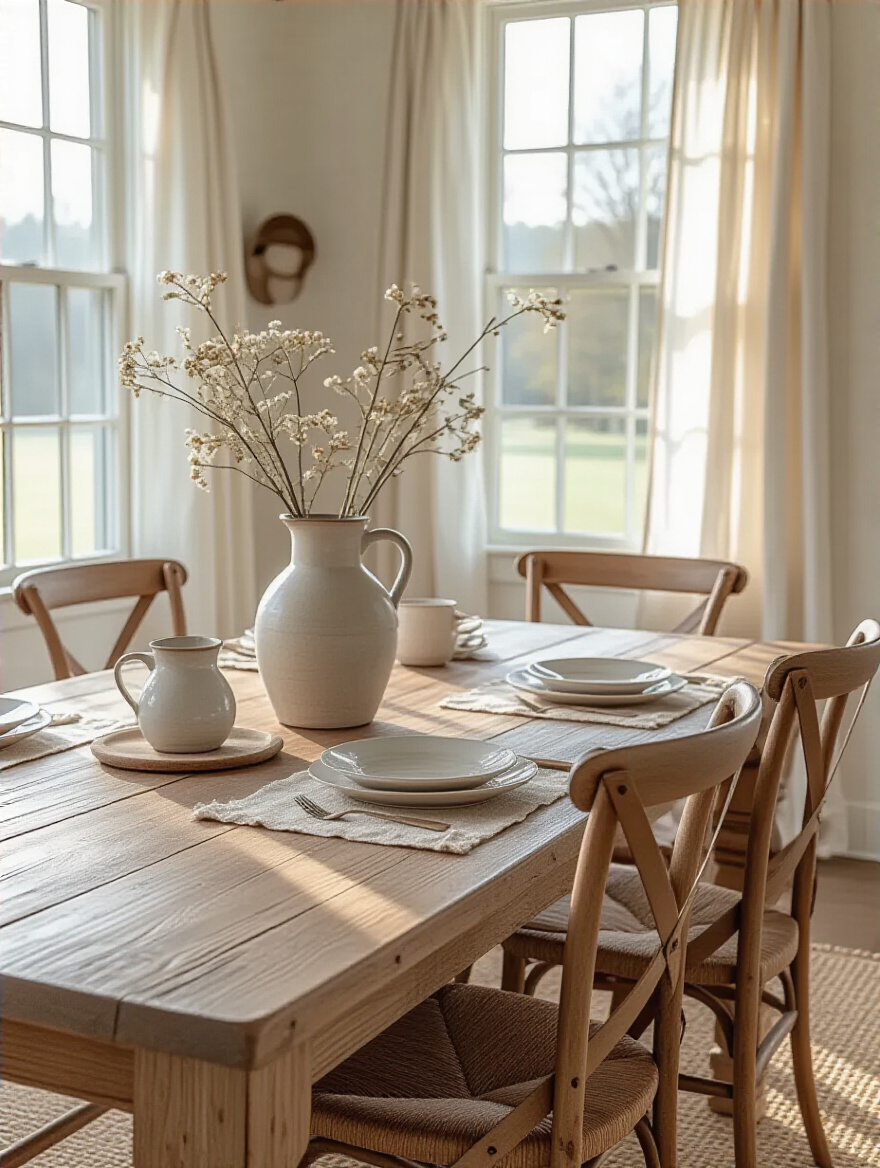
Everyone wants to blow their budget on trendy light fixtures or a dozen little decor items from a big-box store. Don’t. A cheap table will wobble, a cheap chair will be uncomfortable, and you’ll hate them within a year. But a solid, well-made table can last a lifetime and become an heirloom. You can always find a cool vintage light fixture or affordable decor later. Prioritize the core pieces that impact your physical comfort.
Think of it like this: your table and chairs are the meal. Everything else is just the garnish. Spend your money on the meal.
Anchoring Your Space: Essential Furniture and Fixture Selections (Part 1)
With your plan in hand, you’re ready to start selecting the pieces that will anchor the room. These are the big, defining elements that will do most of the heavy lifting in creating that authentic farmhouse feel. Let’s get these right, and the rest will fall into place.
7. Invest in a Solid, Reclaimed Wood Dining Table as the Heart of the Room
There’s a reason reclaimed wood is so central to this style, and it’s not just about looks. It’s psychological. A brand new, perfectly smooth table can feel sterile and intimidating. But a reclaimed wood table has a history. Every knot, ding, and grain pattern tells a story. This inherent imperfection makes it feel approachable and honest. It says, “Life happens here. Spills are okay. Laughter is welcome.” It’s an instant soul-infuser.
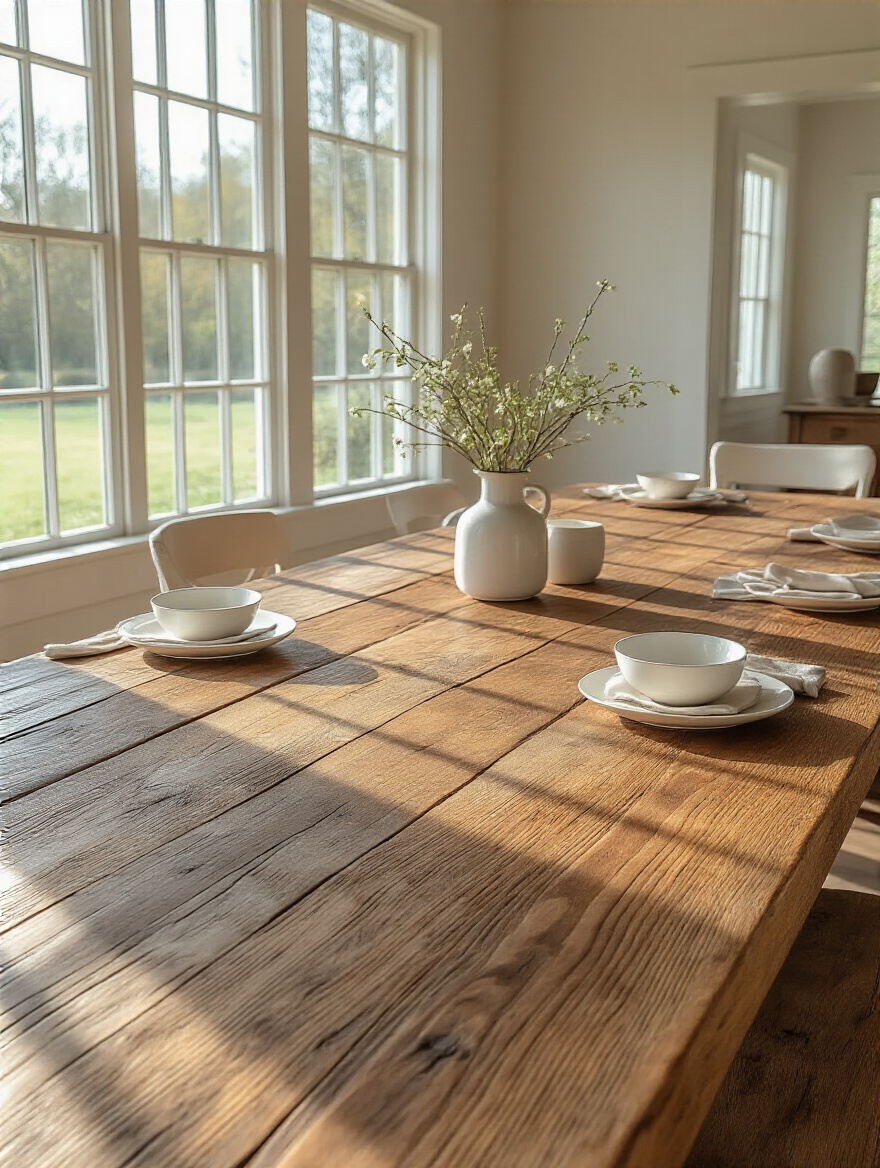
You’re not just buying a piece of wood; you’re buying a grounding force for your home. It has a warmth and presence that can’t be replicated by a factory-made piece. Think of it as the wise old grandparent of your dining room—stable, full of stories, and the undeniable center of gravity. A client once told me their reclaimed barn wood table “felt like it had good energy.” They were right.
This will likely be your biggest investment, so make it a good one. It’s the piece that will give your room its voice.
8. Select Comfortable and Character-Filled Dining Chairs
Chairs are a subconscious signal to your guests. Hard, upright, uncomfortable chairs quietly whisper, “Please don’t stay too long.” Soft, supportive, comfortable chairs say, “Settle in. Have another glass of wine. The stories are just getting started.” Comfort is non-negotiable. If you’re testing a chair, sit in it for at least five minutes. If you’re already fidgeting, it’s the wrong chair.
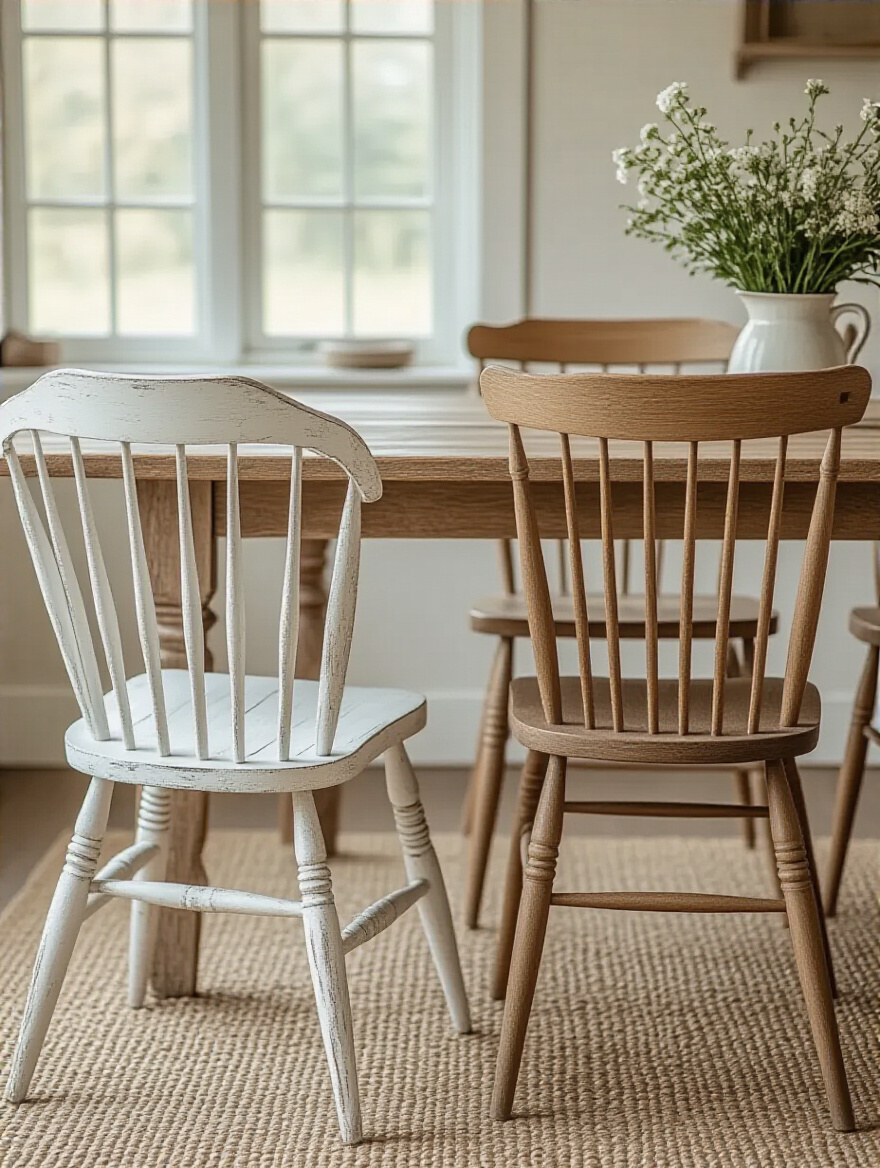
And please, get over the idea that everything has to match. The most charming farmhouse dining rooms often feature a mix of chair styles. It creates a “collected over time” look that feels authentic and unstaged. Maybe you have a bench on one side, a few classic wooden chairs on the other, and two plush, upholstered captain’s chairs at the ends. This mix adds so much personality and makes the space feel incredibly welcoming.
Think of your chairs as individual invitations. Make them good ones. This is the place to prioritize comfort and express a little personality.
9. Install a Statement Lighting Fixture with Vintage or Industrial Appeal
Lighting isn’t just for seeing your food; it’s for setting the entire emotional tone of the room. It’s the “jewelry of the space,” as they say. And for a farmhouse look, something with vintage or industrial bones is a shortcut to instant character. These styles evoke a sense of history, craft, and rugged honesty that perfectly complements the rustic vibe. It’s a way to add texture and a strong focal point without cluttering the walls with art.

Here’s the key: scale and placement. A tiny fixture over a huge table looks ridiculous. A good rule of thumb is that the fixture should be about one-half to two-thirds the width of your table. And it should hang 30-36 inches above the tabletop—low enough to feel intimate, but high enough that you don’t knock your head on it. And for the love of all that is good, install a dimmer switch. It’s the single most impactful, low-cost upgrade you can make for creating ambiance.
This is your chance to add a dose of drama. A great light fixture can completely transform a room, making it feel curated and intentional.
10. Incorporate a Functional and Stylish Farmhouse Hutch or Sideboard
A hutch or sideboard is your storytelling piece. Everyone else will tell you it’s for storage, and it is. But more importantly, it’s a stage. It’s where you can display the things that make your house a home—your grandmother’s china, a stack of your favorite cookbooks, a wonky piece of pottery your kid made. This is what separates a real, soulful home from a catalog showroom.
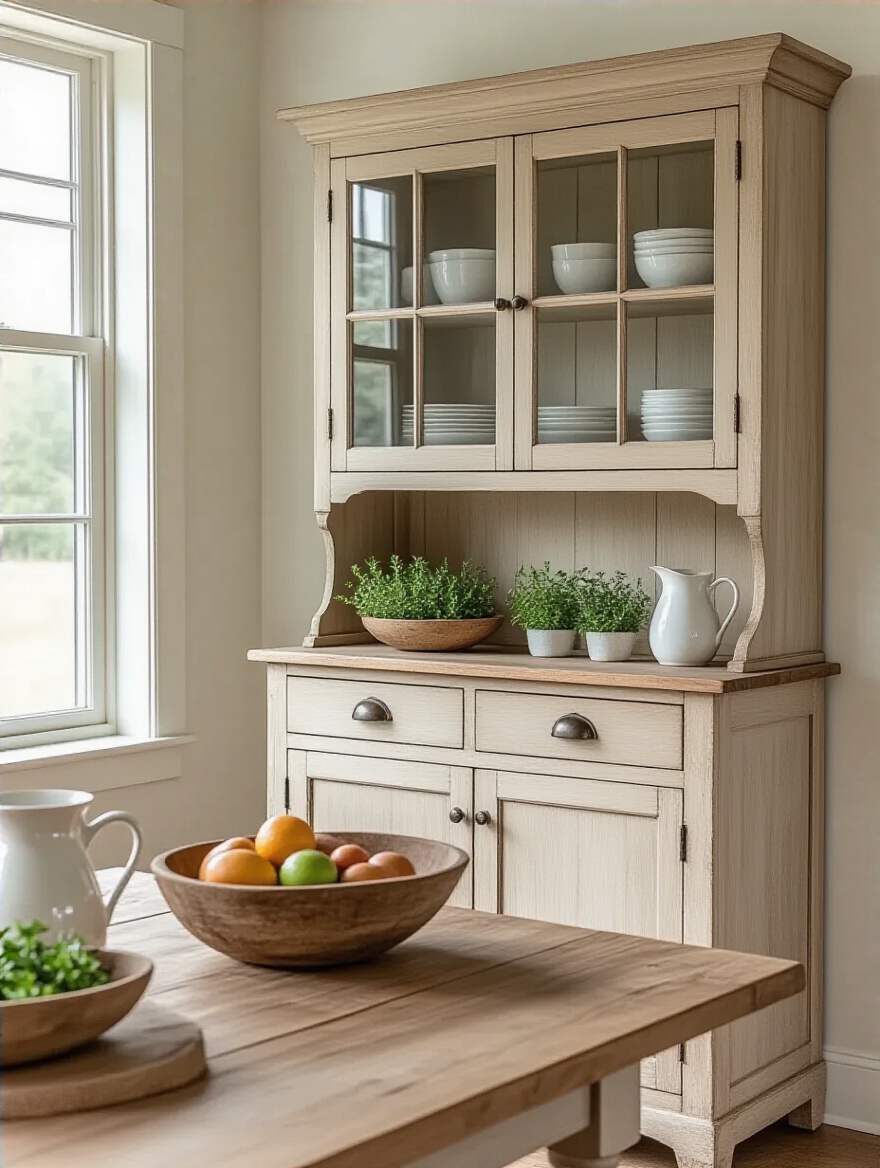
The BS advice is to fill it with generic, color-coordinated decor. Please don’t. That tells no story at all. The real magic happens when you mix functional items (like stacks of everyday plates or glasses) with a few deeply personal objects. It creates a display that is both beautiful and honest. It says, “This is us. This is what we love.” It makes your home feel authentic.
Next, we’ll talk about grounding the space from the floor up and making your seating work even harder. These layers add crucial comfort and function.
Anchoring Your Space: Essential Furniture and Fixture Selections (Part 2)
We’ve covered the big players, but a room isn’t finished until you address the floor and the finer details of seating. These elements are what make a space feel complete and truly comfortable, moving it from ‘decorated’ to ‘lived-in’.
11. Ground Your Space with a Natural Fiber Area Rug for Warmth
An area rug is like a hug for your dining room. It defines the space, quiets the room, and adds a crucial layer of texture and warmth. In an open-concept home, it’s a non-negotiable visual cue that says, “This is the dining area.” It anchors the table and chairs, keeping them from feeling like they’re floating in space. A natural fiber rug—like jute, sisal, or seagrass—is perfect for the farmhouse style because its organic texture feels grounding and unpretentious.
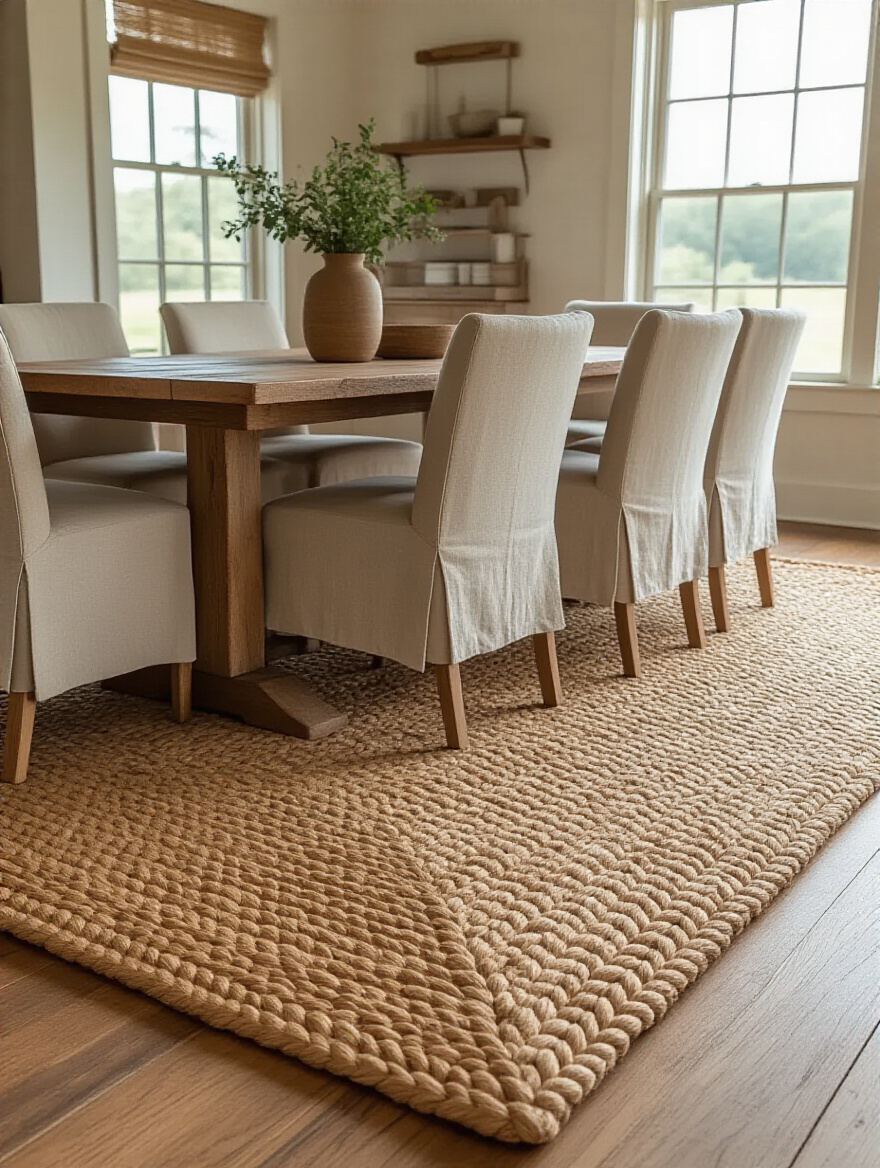
The number one mistake people make is buying a rug that’s too small. It’s a classic rookie error. When you pull the chairs out to sit down, all four legs of the chair should still be on the rug. If they’re not, the chair will snag on the edge, and the whole arrangement will look cramped and cheap. The shortcut: measure your table, add 24 inches to every side, and buy a rug that fits those dimensions. Go big or go home.
This one piece will tie everything together. Don’t underestimate its power to make your dining room feel cohesive and intentional.
12. Consider Adding a Rustic Bench for Versatile and Communal Seating
There is something deeply communal about a bench. Unlike individual chairs, which create clear personal space, a bench encourages people to cozy up and share. It’s an instant signal of informality and welcome. From a psychological standpoint, it breaks down barriers and fosters a more relaxed, family-style atmosphere. Plus, it’s incredibly practical for families with kids—you can always squeeze one more on.
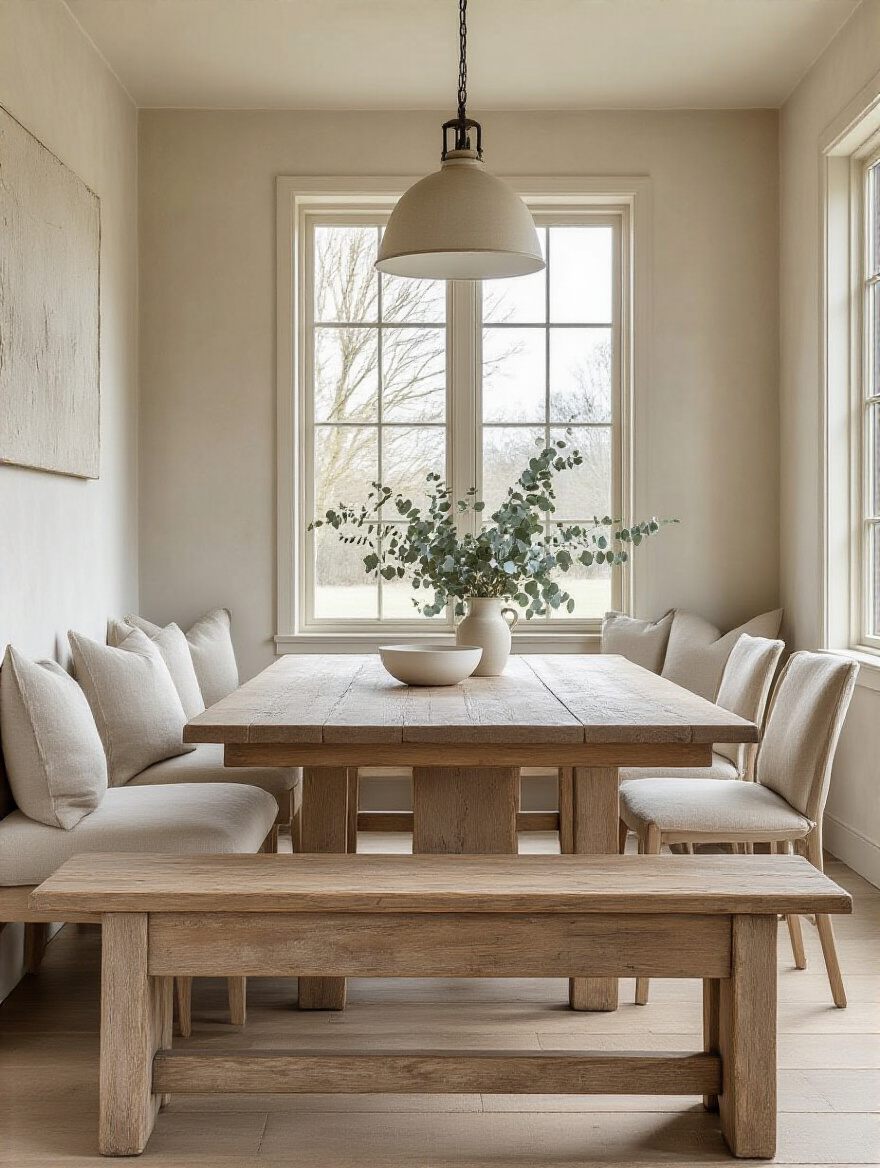
A simple, rustic wood bench on one side of your table is a fantastic way to break up the monotony of a matching chair set. It adds visual interest and a casual, laid-back vibe that is the essence of farmhouse living. I once suggested a bench to a client who was worried her dining room felt too stuffy. The change was immediate. It was the same table, but suddenly the room felt ten times more inviting.
Now that the main pieces are in place, it’s time to layer in the personality. This is the fun part, where we add the touches that make the space uniquely yours.
Infusing Warmth and Personality: Layering Textures and Accents (Part 1)
This is where the magic really happens. Your furniture is the foundation, but these layers are what will make the room sing. This is how you infuse warmth, tell your story, and create a space that feels deeply personal and alive.
13. Adorn Your Table with Simple, Elegant Linens and Runners
Hard surfaces can feel cold and unwelcoming. Textiles are the antidote. A simple linen runner or some soft cotton placemats can completely change the feel of a table, adding a layer of softness, texture, and care. It’s a subtle cue that says, “I made an effort. I wanted this to be special.” It elevates an everyday meal into a small occasion.
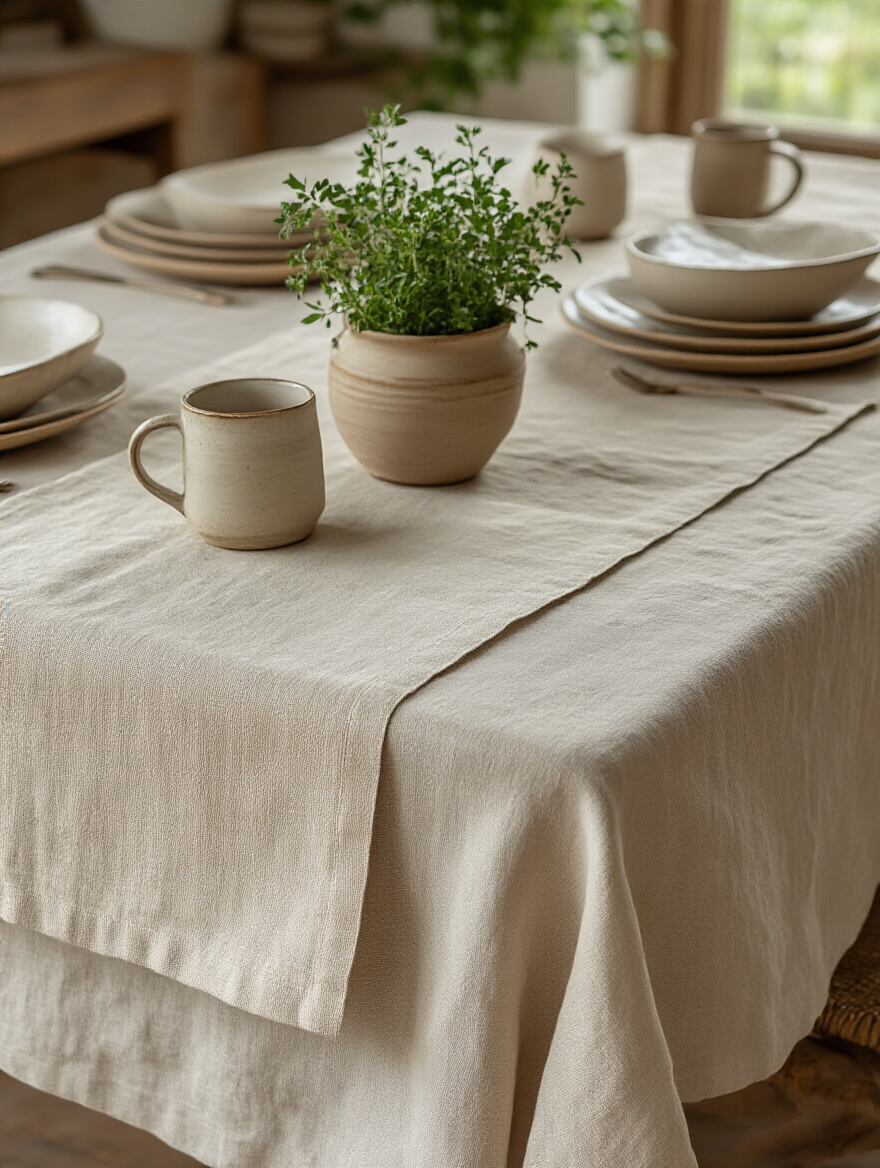
Forget about stiff, perfectly ironed tablecloths. That’s not the vibe. The beauty of farmhouse style is its relaxed sophistication. Go for natural fabrics like linen and embrace the wrinkles. A slightly rumpled, stonewashed linen runner has an effortless elegance that feels authentic and inviting. This is the easiest, most affordable way to add a touch of warmth and change up your look with the seasons.
Next, let’s talk about the walls. A blank wall is a missed opportunity for storytelling and adding character.
14. Curate Wall Art: Mix Vintage Prints with Galvanized or Wood Accents
Please don’t go to a big-box store and buy a generic “EAT” sign. Your walls are prime real estate for showing your personality. A curated gallery wall is a perfect way to do this in a farmhouse style. The key is to mix textures and materials. Combine a few vintage botanical prints with a rustic wooden frame and maybe a small galvanized metal accent.
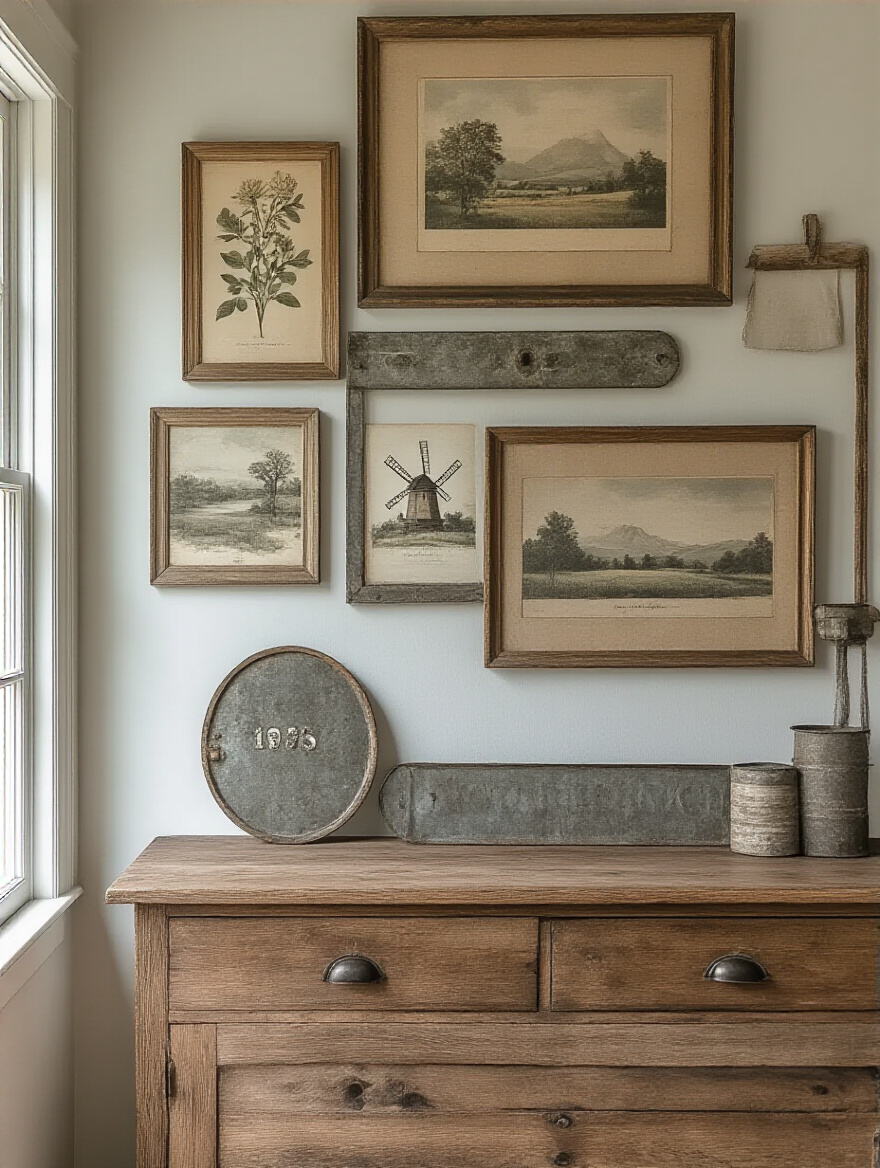
“A successful gallery wall in a farmhouse dining room isn’t about matching everything perfectly; it’s about curated imperfection.”
This mix of materials—the softness of the paper, the roughness of the wood, the coolness of the metal—creates incredible visual interest and depth. And the content should be personal! Frame a treasured family recipe, a pressed flower from your garden, or a cool old patent drawing of a whisk. Tell your story, not a generic one.
With the walls telling a story, let’s bring that same level of intention to the centerpiece of the room: the table itself.
15. Display Charming Tabletop Decor: Earthenware, Ceramics, and Fresh Florals
Your tabletop decor should feel alive, not static. The best way to achieve this is by bringing in natural and handmade elements. A collection of simple earthenware pitchers, a stack of ceramic bowls, and, most importantly, something living. Fresh flowers, a branch cut from your yard, or a bowl of seasonal fruit instantly breathes life into a room.
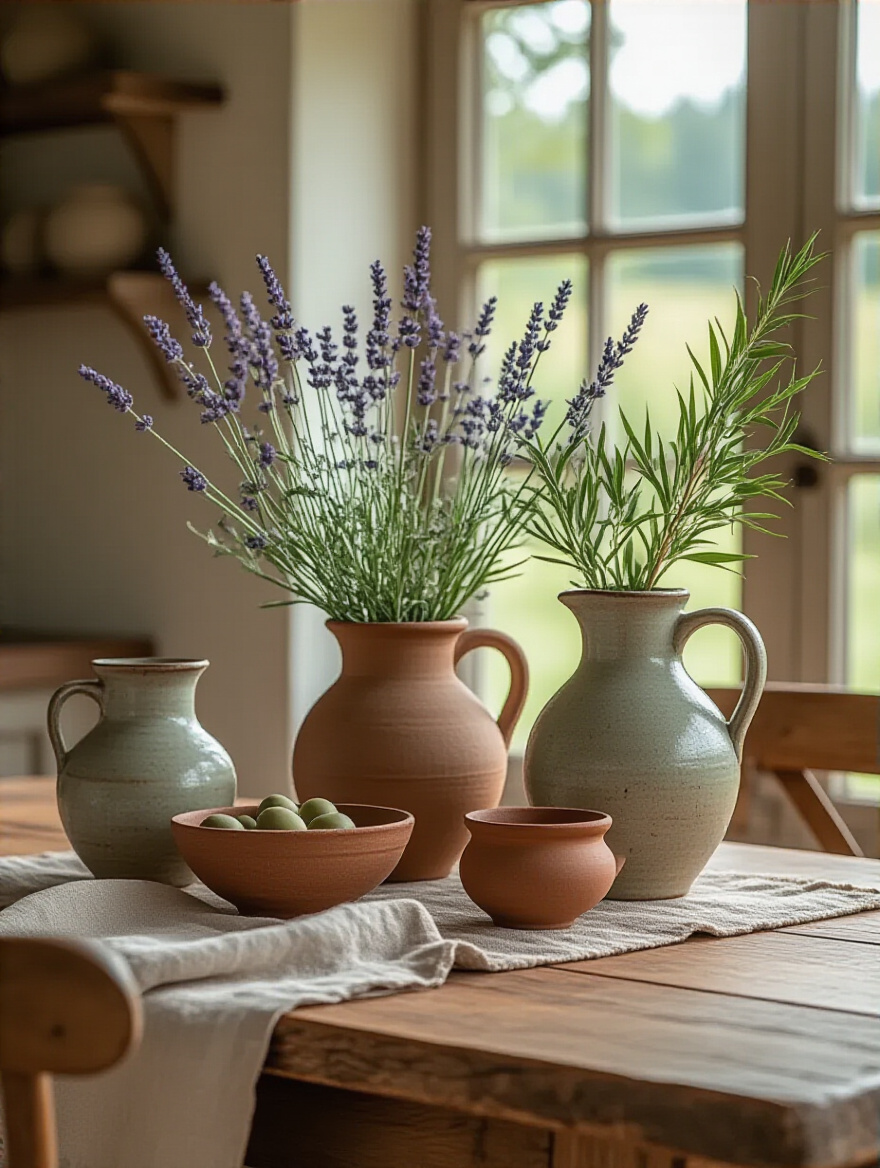
These natural elements create a connection to the outdoors, which is at the core of the farmhouse philosophy. They signal vitality and care. Avoid anything that looks too perfect or mass-produced. Instead, look for pottery with subtle imperfections or flowers that look like they were just gathered from a field. It’s this touch of the “perfectly imperfect” that makes a space feel warm and authentic.
The final element in setting the mood is the one most people overlook. It’s not just what you see, but how you see it.
16. Introduce Soft Lighting with Candles, Lanterns, or Dimmable Fixtures for Ambiance
I said it before and I’ll say it again: dimmers are non-negotiable. But to truly create an inviting atmosphere, you need to layer your light. One overhead fixture isn’t enough. Our brains are hardwired from our cave-dwelling ancestors to feel safe and relaxed around sources of warm, flickering light. It signals community, safety, and the end of the day.

So, bring in the candles. A cluster of pillar candles on the table or sideboard can instantly transform the mood. Use vintage-style lanterns with battery-operated LED candles for a safe, charming glow. This layering of soft, warm light from different heights is what creates that magical, intimate ambiance that makes people want to linger for hours after dinner. Harsh overhead lighting is a conversation killer. Soft, layered lighting is an invitation to connect.
We’re in the home stretch now. Let’s focus on adding those final layers of character and practicality that make a room truly sing.
Infusing Warmth and Personality: Layering Textures and Accents (Part 2)
These last few touches are about celebrating real life. It’s about creating a space that is not only beautiful but also honest, living, and breathing with the rhythm of your home.
17. Utilize Open Shelving for Displaying Collectibles and Dishware
Open shelving can be intimidating, but it’s a secret weapon for creating an authentic farmhouse feel. Why? Because it’s honest. It says, “This is the stuff we actually use.” Instead of hiding your plates behind a cabinet door, displaying them on open shelves turns everyday objects into art. It creates a sense of casual, accessible beauty that is incredibly welcoming.
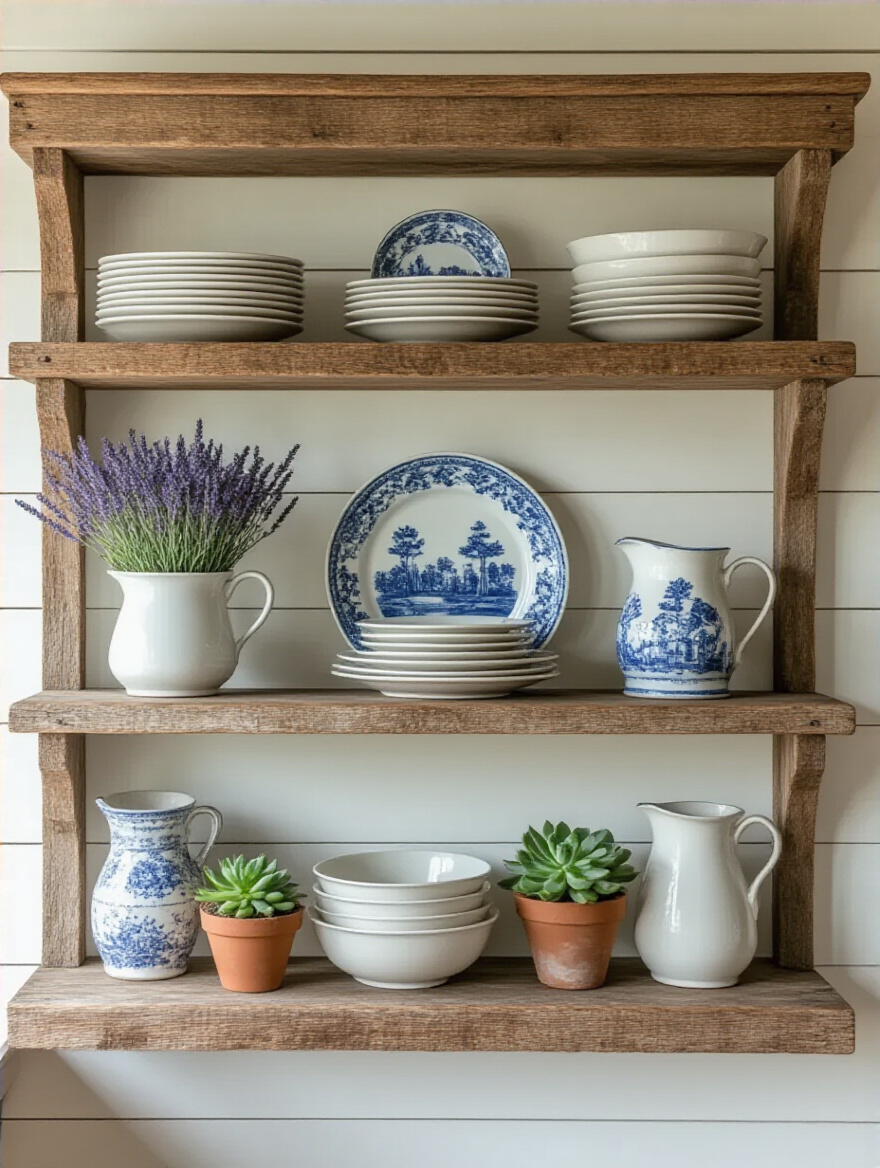
The trick is curation. This isn’t the place for your mismatched plastic cups. Reserve it for your simple white dishes, a stack of linen napkins, your favorite mugs, and a few pretty serving bowls. It’s a design choice that forces you to be intentional about what you own. I had a client who was terrified of open shelves until we installed them. She said it made her feel more connected to her home and encouraged her to only keep things she truly loved.
Open shelving brings the ‘inside out’. Our next tip does the opposite, bringing the ‘outside in’ for a crucial dose of vitality.
18. Add Greenery: Potted Herbs, Faux Olive Trees, or Farm-Fresh Blooms for Life
A room without something green feels dead. Period. We have a deep, biological need to be connected to nature—a concept called biophilia. Bringing plants into your dining room is one of the easiest and most powerful ways to improve the feel of the space. It instantly adds life, color, and organic texture.
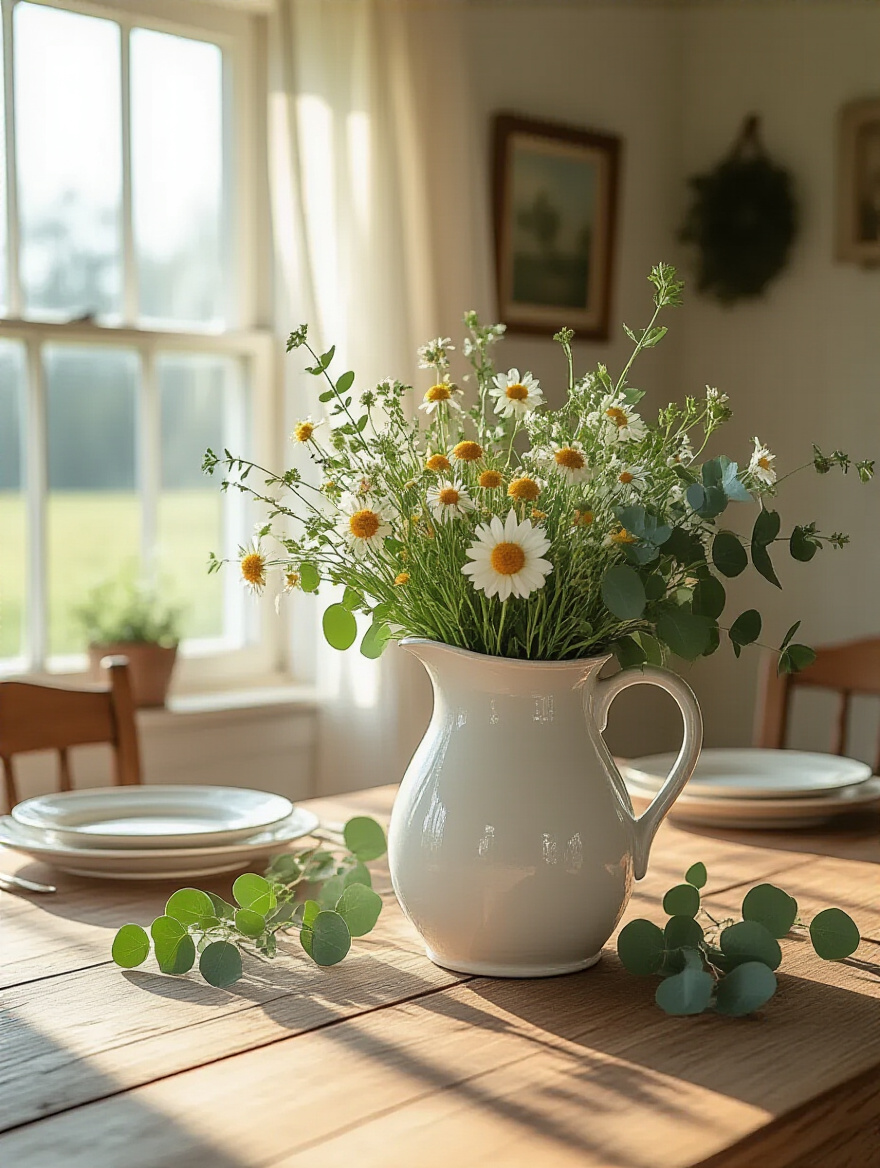
It doesn’t have to be complicated. A small pot of herbs on the windowsill, a high-quality faux olive tree in a corner, or a simple vase of wildflowers on the sideboard is all it takes. The green softens all the hard edges of the furniture and wood, making the entire room feel more vibrant and welcoming. It’s the design equivalent of opening a window and letting in a fresh breeze.
With the room fully decorated, our final focus is on the little details that ensure the space is as practical as it is pretty, both for today and for years to come.
Refining the Details: Seasonal Touches and Long-Term Enjoyment (Part 1)
A truly great room isn’t just a static picture; it evolves and adapts. These final steps are about making your dining room a flexible, functional, and joyful space that can handle the messiness of real life while staying beautiful.
19. Maximize Storage with Stylish Wicker Baskets and Glass Apothecary Jars
Clutter is the enemy of calm. From a psychological standpoint, visible clutter sends a constant, low-grade stress signal to our brains. Smart storage is the solution, and for a farmhouse look, wicker baskets and glass jars are your best friends. They’re not just containers; they are decorative elements that add crucial texture and charm.
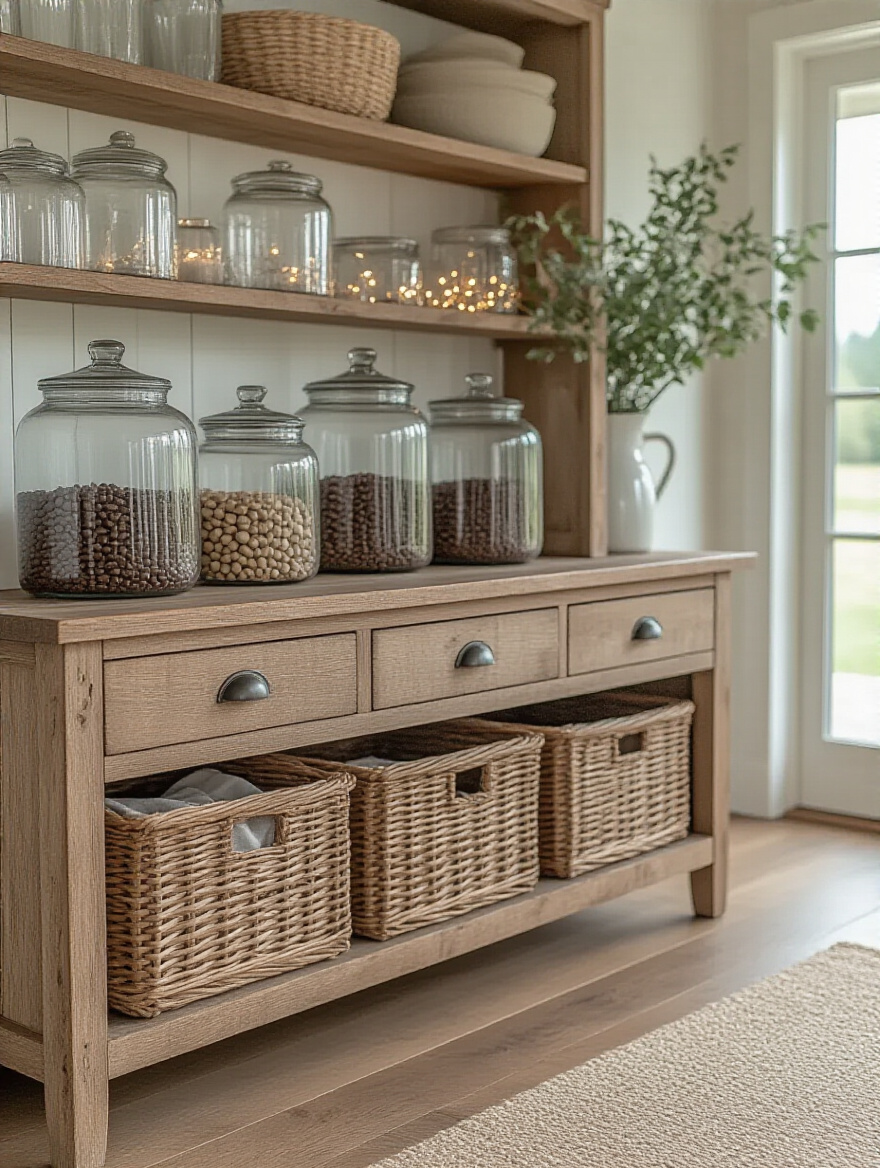
Use large wicker baskets under a sideboard or bench to stash away less-pretty essentials like extra placemats or kids’ art supplies. Use glass apothecary jars on open shelves to beautifully display functional things like coffee beans, pasta, or cloth napkins. This approach turns storage into decor, keeping your room organized and serene while enhancing the aesthetic. It’s functional beauty at its best.
Personal touches are what elevate a room from ‘designed’ to ‘cherished’. Here’s how to do it authentically.
20. Incorporate Thoughtful DIY Touches for Unique Character and Storytelling
There’s a psychological principle called the “IKEA effect,” which shows we place a significantly higher value on things we help create. That’s why a DIY project, even an imperfect one, can mean more to you than a pricey store-bought item. Infusing your dining room with a thoughtful, handmade touch is the ultimate way to make it uniquely yours.
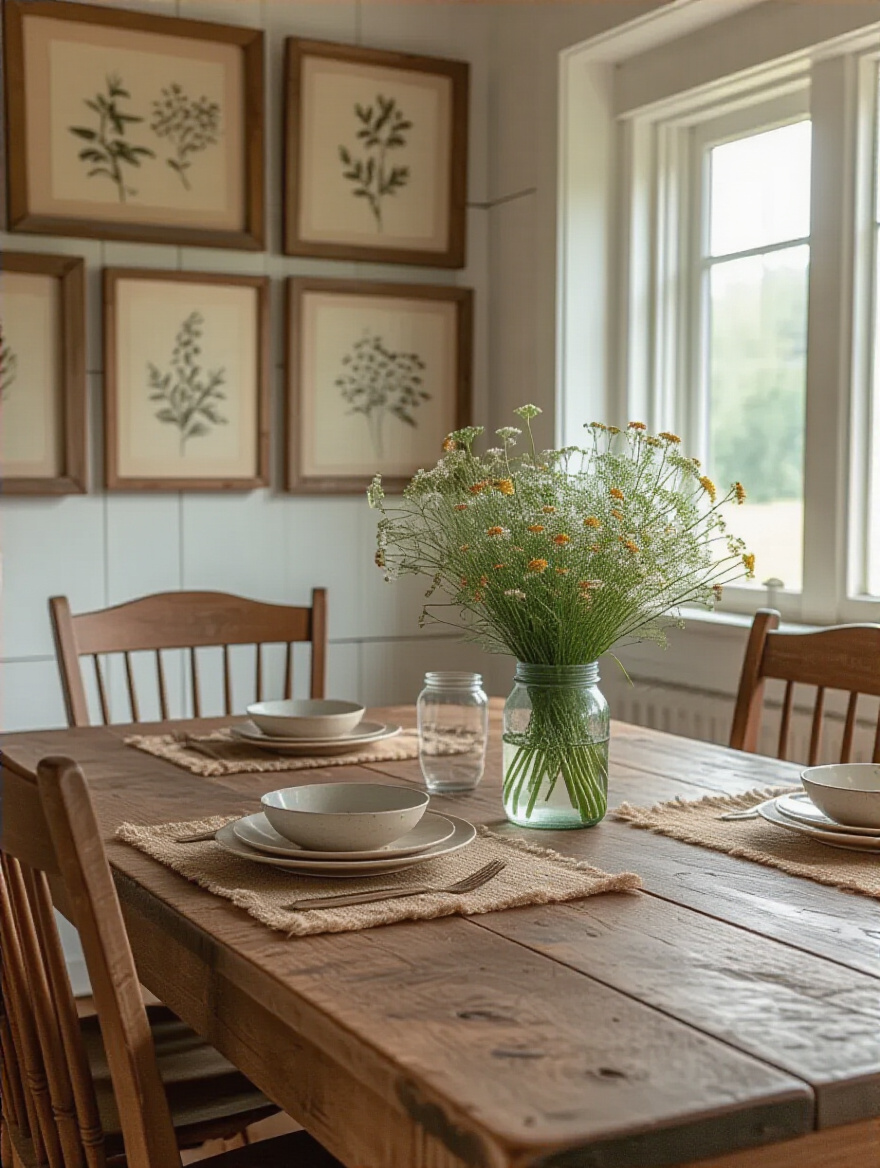
This doesn’t mean you need to be a master woodworker. It could be as simple as painting an old picture frame, creating a sign on a piece of reclaimed wood, or framing a sentimental piece of fabric. I had a client who was on a tight budget, so we found an old wooden ladder at a flea market, cleaned it up, and propped it against a wall to use as a display for cozy blankets. It cost them $20 and became their favorite thing in the room because they had a hand in it.
The best rooms are the ones that work the hardest. Let’s look at making your dining room more than just a place to eat.
21. Create a Cozy Reading Nook or Beverage Station within the Dining Area
Why should your dining room only get used for an hour a day? By carving out a small, multi-functional zone, you can make it one of the hardest-working rooms in your house. A little-used corner can become a cozy reading nook with a single comfy chair and a small lamp. An underutilized sideboard can become a beloved coffee or wine station with just a few additions.
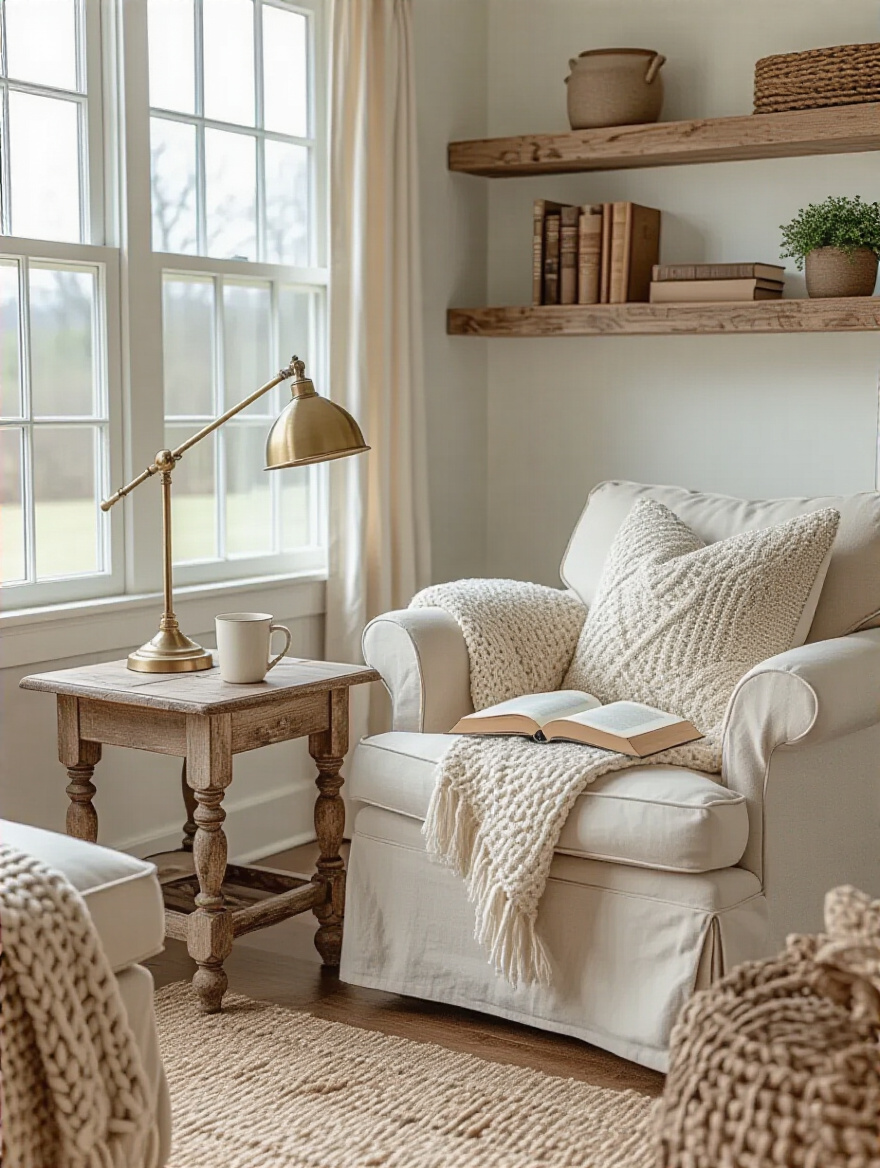
Creating these “zones within zones” makes the entire home feel more functional and inviting. It gives family members a place to retreat to or guests a place to help themselves, making everyone feel more at home. A small breakfast nook my clients added to their dining area ended up being where their kids did homework and where they had their morning coffee, completely transforming how they used and loved the space.
A great space should reflect the time of year. Let’s talk about keeping your room fresh and festive without a total overhaul.
22. Embrace Seasonal Decor for Effortless Updates and Holiday Cheer
The key to successful seasonal decor is subtlety. Please, step away from the inflatable Santas. In a farmhouse setting, the best seasonal touches are rooted in nature. For fall, think less plastic pumpkins and more real gourds, bowls of apples, and branches of colorful leaves. For winter, it’s about evergreen boughs, pinecones, and the warm glow of extra candles.
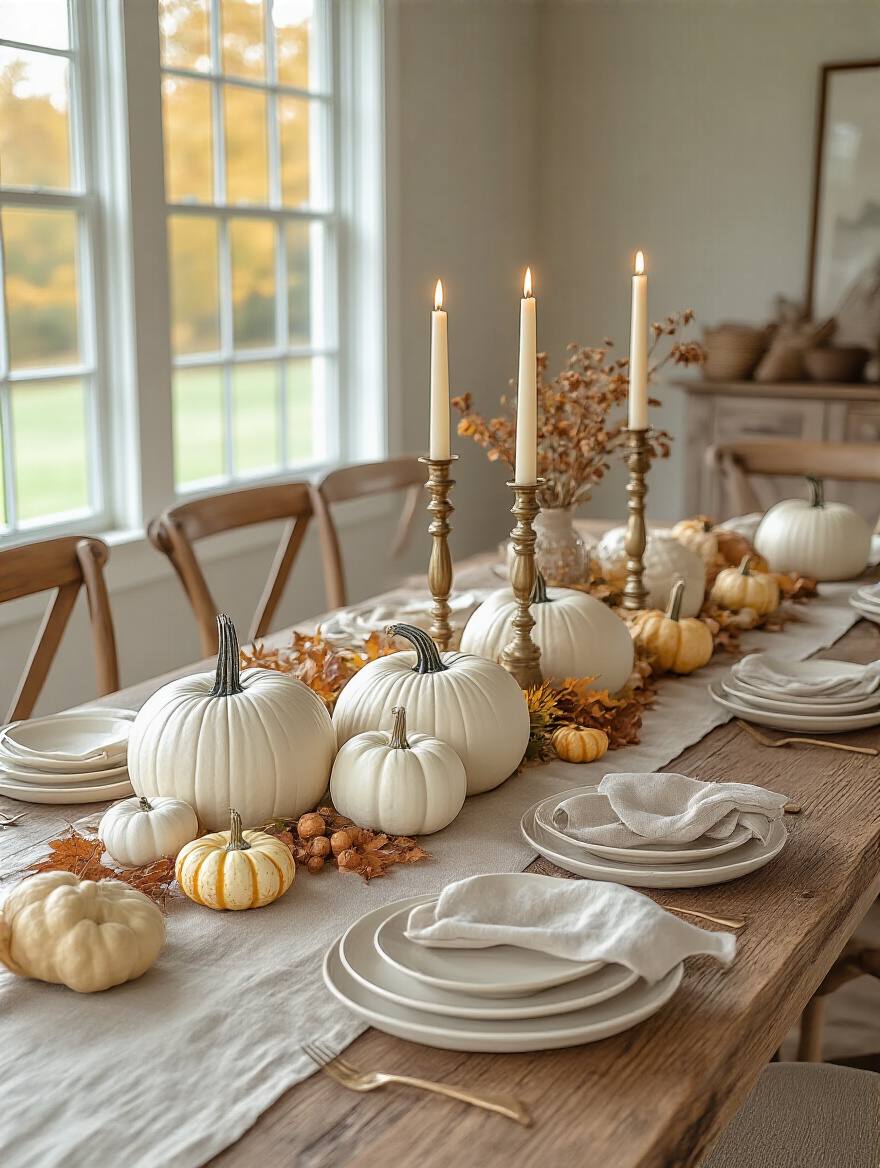
By building on your neutral, textured base, you only need a few small changes to completely shift the mood of the room. A different table runner, a new wreath on the wall, a centerpiece of seasonal blooms—that’s all it takes. This practice of marking the seasons inside your home is a wonderful way to feel more connected to the world outside and keep your space from ever feeling stale.
Let’s wrap this up with two final principles that are less about what you do and more about a mindset that will guarantee you love your room for years to come.
Refining the Details: Seasonal Touches and Long-Term Enjoyment (Part 2)
We’re at the end, but these two points are arguably the most important for your long-term sanity and happiness. This is about making smart choices that will serve you well beyond the initial decorating phase.
23. Prioritize Durability and Easy Maintenance for High-Traffic Furniture
This isn’t glamorous, but it’s crucial. Your dining room is a high-traffic, high-spill zone. Choosing furniture that can’t stand up to real life is a recipe for constant stress. There is nothing relaxing about a room where you’re constantly worried about water rings and stains. This is where you need to be ruthless about practicality.
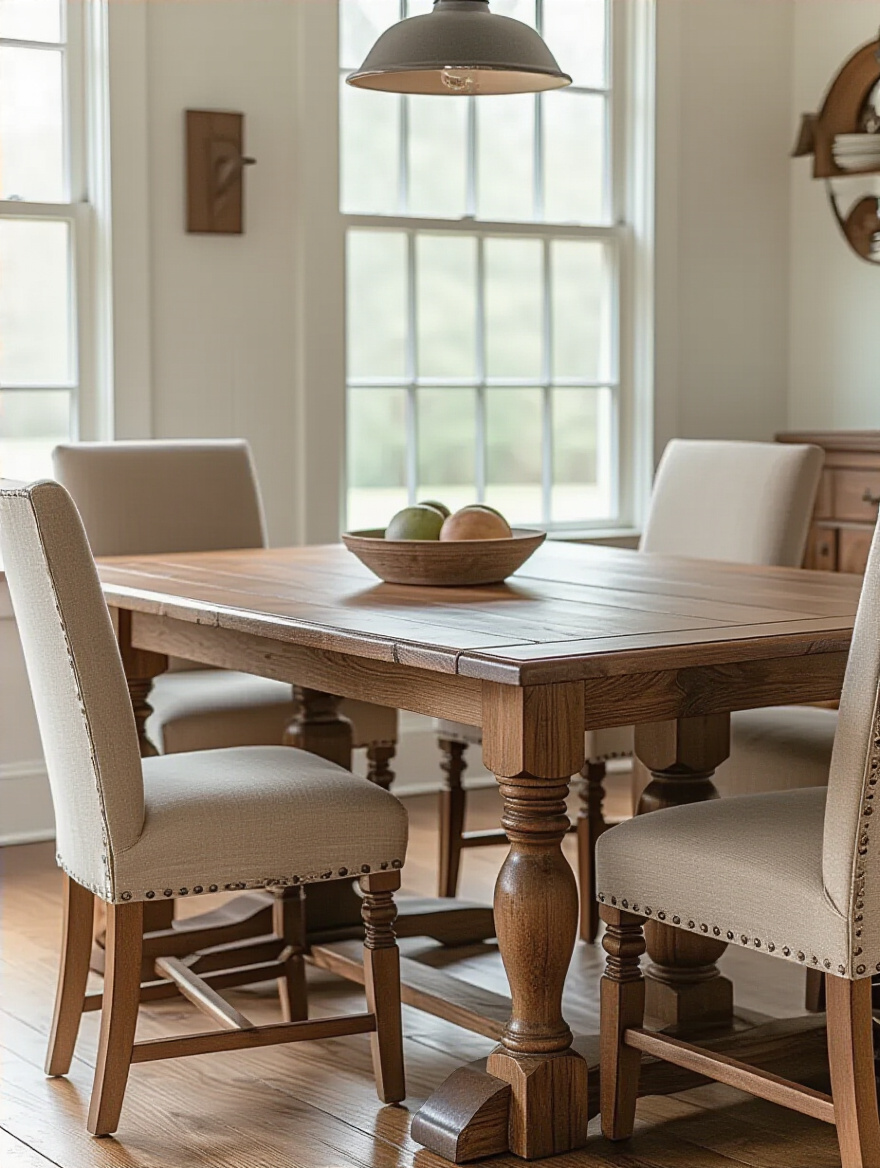
That means a solid wood table with a protective sealant. It means chairs upholstered in a performance fabric that repels stains. It means finishes that can be wiped down easily. I know that delicate linen chair looks beautiful in the showroom, but picture your nephew spilling grape juice on it. True beauty in a family home is resilience. Choosing durable, low-maintenance furniture is an act of self-care.
Finally, the most important design principle of all, and the hardest one to follow in our consumer culture.
24. Avoid Over-Decorating: Embrace Simplicity and Functional Beauty
The goal is not to fill every inch of space. The goal is to create a space that feels calm and breathable. Our brains get overwhelmed by too much visual information. A cluttered, over-decorated room is visually “loud” and mentally exhausting. Farmhouse style at its best is about a kind of beautiful, functional simplicity.
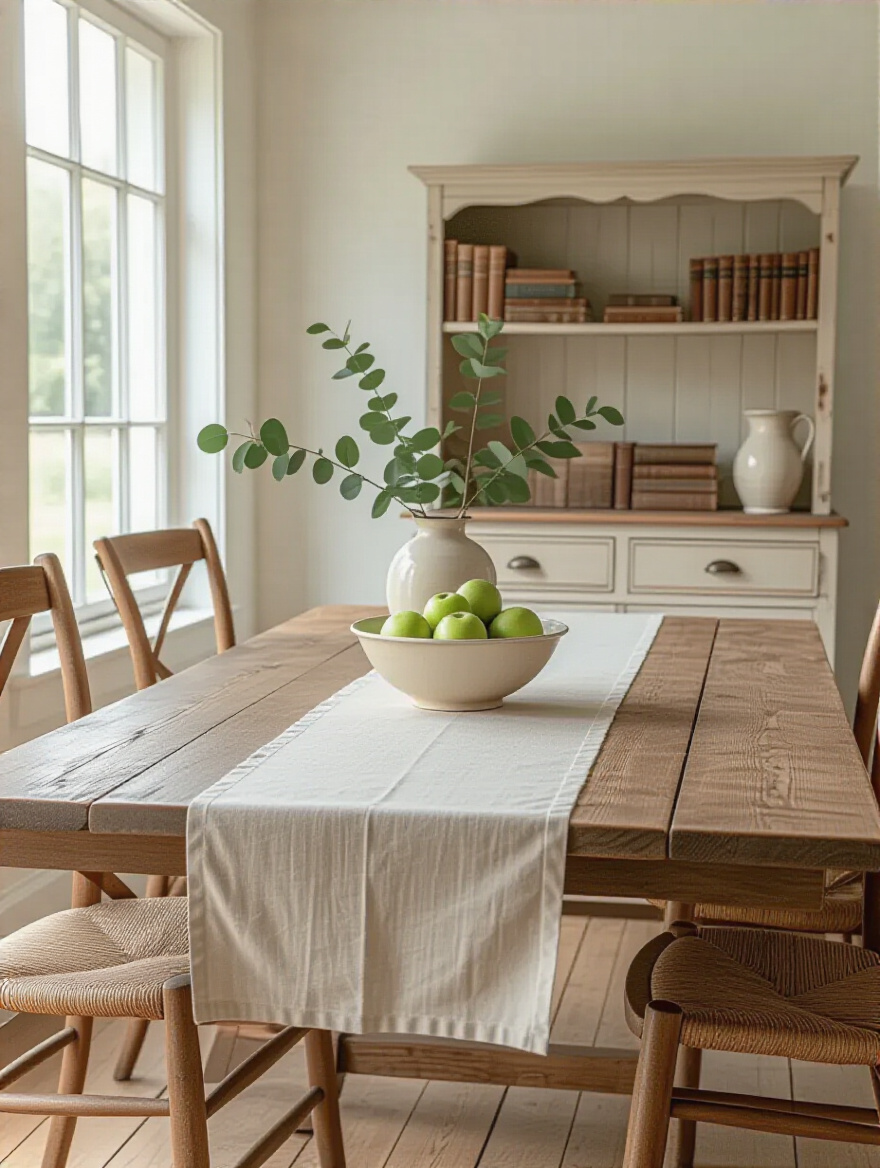
So, edit ruthlessly. Let the beautiful texture of your wooden table be the star. Let a single, beautiful vase of flowers be the centerpiece. Embrace negative space—the empty bits on walls and surfaces. This visual quiet is what allows the soul of the room to emerge. It gives your eyes a place to rest and your mind a chance to relax. Don’t just decorate. Curate.
Conclusion
So there you have it. Creating a farmhouse dining room with real soul has almost nothing to do with buying the right stuff from a catalog. It’s about understanding the “why” behind your choices. It’s about creating a space that makes you and your loved ones feel safe, welcome, and relaxed. It’s about telling your unique story through layers of texture, history, and personal touches. The real secret is that the best rooms aren’t decorated; they’re authored.
Don’t get overwhelmed. Just start with one thing. Maybe it’s clearing off your dining table and putting a single vase of branches on it. Or maybe it’s finally buying that dimmer switch. Take one small step toward creating a room that doesn’t just look good, but feels good. Your home is the backdrop of your life—make it a place that truly supports and inspires you. You deserve nothing less.
